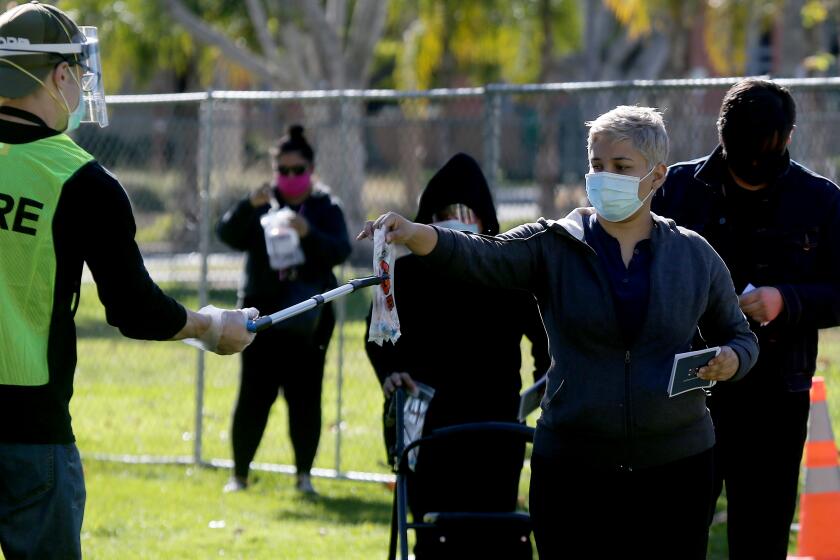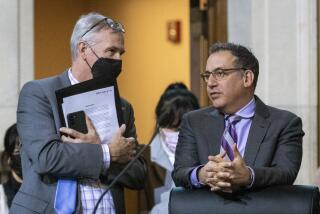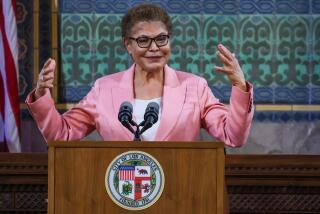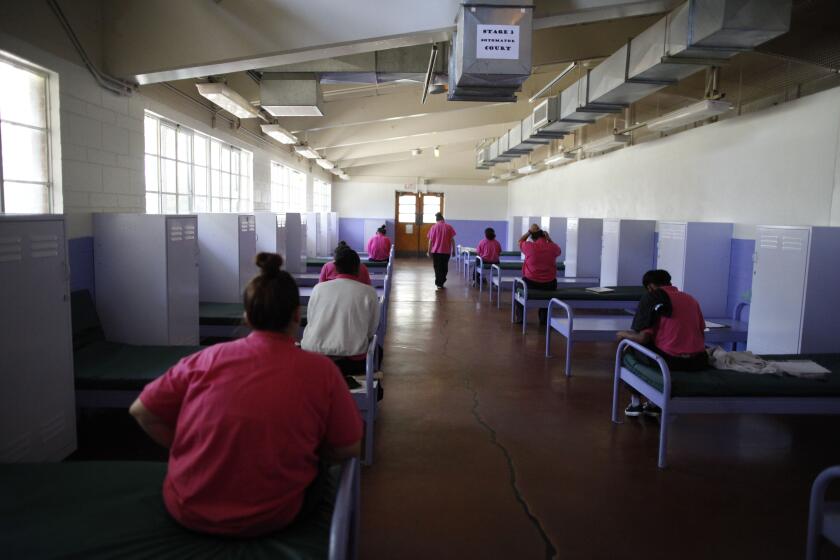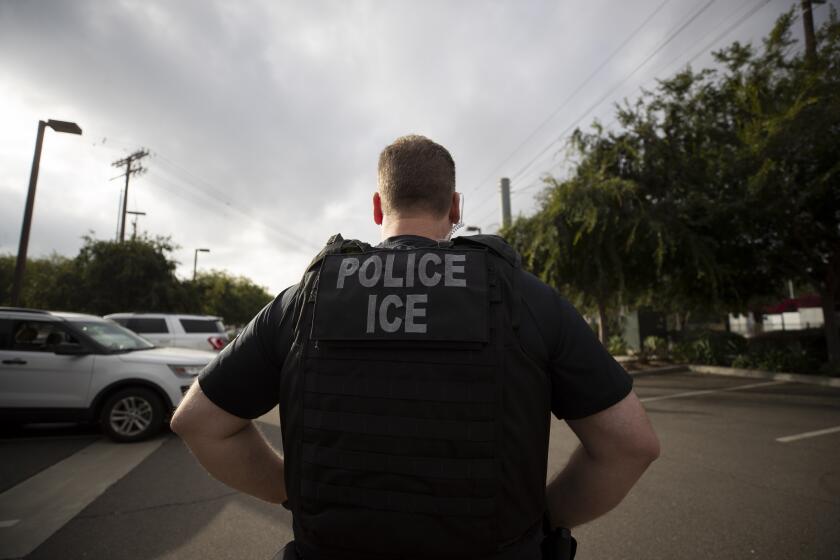Garcetti vetoes plan to use reallocated LAPD money for disadvantaged communities
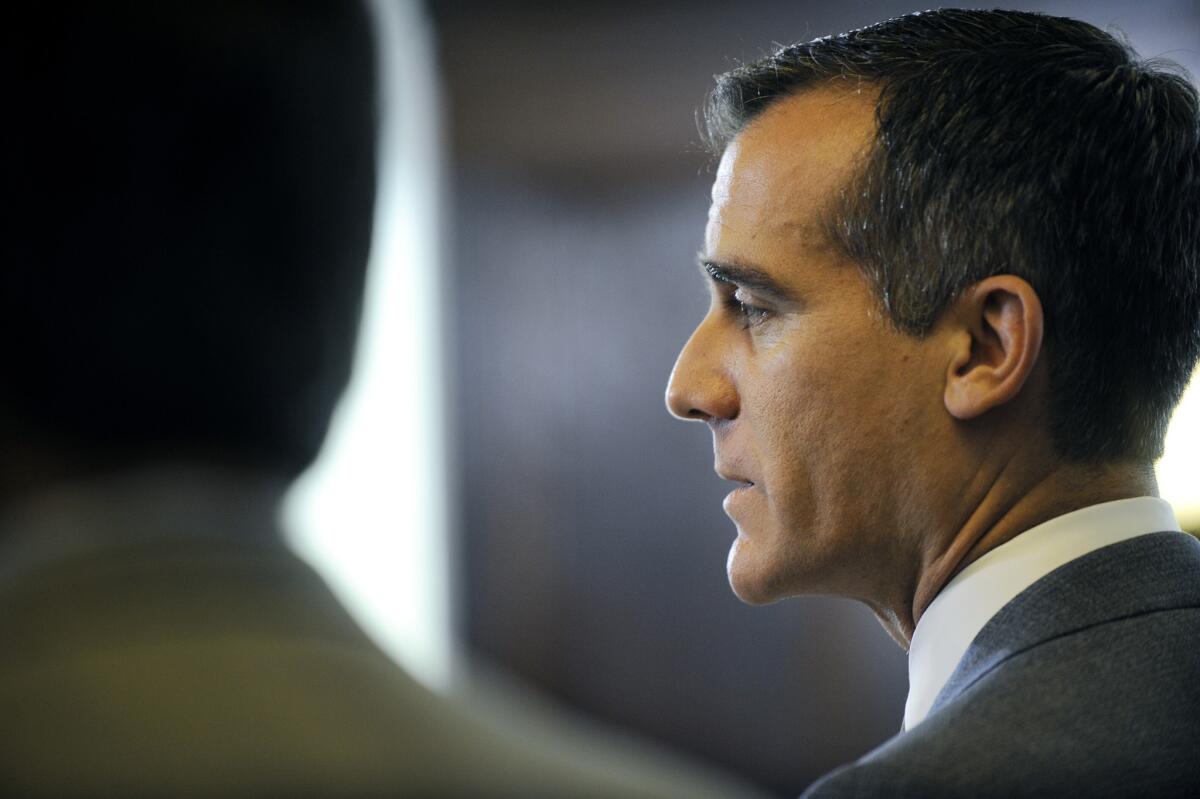
- Share via
Los Angeles Mayor Eric Garcetti has vetoed a proposal backed by the City Council to spend money diverted from the Los Angeles Police Department’s budget on an array of services, including sidewalk repairs.
Employing a veto power that he rarely uses, Garcetti called for the money to be focused on addressing racial justice and income inequality, avoiding layoffs and more.
“Far too many of the proposed expenditures do not meet the demands of the moment or the call of history,” Garcetti wrote in a letter to the council late Monday about its proposal.
Some council members criticized Garcetti’s action, saying the mayor didn’t give any feedback on the spending plan before Monday.
Councilman Marqueece Harris-Dawson, who represents a district that stretches from Baldwin Hills to the edge of Watts, said he would seek to override Garcetti’s veto. That would require 10 council votes.
The council earlier this month backed a spending plan for tens of millions of dollars that was originally budgeted for the LAPD, but reprogrammed in response to protests this summer over policing and racial injustice.
That plan, passed on a 13-2 vote, set aside $88 million for youth and recreation programs, neighborhood beautification initiatives, job and business programs, nonprofit services and more.
The spending list wasn’t final and was expected to come back before the council in February. Still, it drew fire from LAPD Chief Michel Moore and the police union, who criticized it for including funding for public works projects at a time of rising homicides and shootings. The union also accused council members of creating a slush fund for their districts.
The bulk of the money was slated to be spent in South L.A. in three districts, but still allowed council members to fund tree trimming, for instance.
Harris-Dawson’s district, which would receive $16.6 million under the proposal, put hiring programs on his potential spending list, as well as park improvements, street and alley resurfacing, tree trimming, and other initiatives, according to the council report.
Garcetti, in an interview Tuesday, said the proposed list included “a lot of stuff that’s just kind of business as usual.”
“Don’t get me wrong, it’s critically important to someone’s quality of life, but I don’t think people hit the streets for us to fix the sidewalks,” he added. “They hit the streets for us to get out there and make some lasting change.”
Garcetti, in his letter, said he would support a revised spending plan that focuses on community engagement on issues such as racial justice and income inequality; protects jobs for city employees facing layoffs, particularly employees hired through a program that targets individuals from underserved populations; antiviolence programs and a pilot program that has mental health workers respond to nonviolent 911 calls.
The numbers show the coronavirus circulating statewide; behaviors thought to be relatively safe weeks ago now carry a higher risk of infection.
Harris-Dawson said he wants to use the reallocated money in his district for gang intervention workers, reentry services, sidewalk repairs and tree trimming. Sidewalk repairs could be done by outside groups, providing jobs in the district, he said.
Garcetti’s letter has a lot of “progressive gobbledygook that doesn’t mean anything,” he said.
“It sounds like from the letter that he is questioning the knowledge of low-income people and their representatives about what they need in the community,” Harris-Dawson said. “He’s saying he knows better.”
Council President Nury Martinez said she was shocked by Garcetti’s veto, saying the spending proposal came after months of discussions with city leaders and community members.
“Residents from Black and brown communities told us they needed more from their city, and this package is one step forward in that process,” said Martinez, who represents the eastern San Fernando Valley. “The City Council will continue to lead and honor our commitments to our communities as we find a path forward.”
Councilman Joe Buscaino, who represents a Watts-to-San Pedro district, backed Garcetti’s move, saying, “I support the mayor’s veto because I did not support these [LAPD] cuts in the first place.”
With the city on pace to have more than 300 homicides this year, “it’s time to reestablish our priorities and focus on delivering critical police and fire resources,” Buscaino said.
Following massive protests during the summer over the death of George Floyd in Minnesota, Martinez and her colleagues said they would cut $150 million from the LAPD to help “disenfranchised” communities.
Some of the money went to help address the city’s financial crisis, including $40 million to delay furloughs and $10 million for the city’s reserve. Another $10 million was earmarked for jobs programs.
That left about $90 million for the council to earmark towards community needs.
Craig Lally, president of the Los Angeles Police Protective League, accused the council earlier this month of laying off hundreds of police officer to fund curb cuts, landscaping and other initiatives.
The council is weighing layoffs for city employees, including hundreds of police officers, to help manage the City Hall fiscal crisis brought about by the pandemic.
On Tuesday, Lally said that Garcetti’s veto “validates our concern that the $90 million City Council slush fund does nothing to reduce the dramatic increase in shootings and murders in our neighborhoods and reeks of old-school political patronage.”
“We’re pleased that the mayor is placing a priority on protecting employees of color from disproportionate layoffs,” he added, noting that the vast majority of police officers targeted for layoffs are people of color.
Times staff writer David Zahniser contributed to this report.
More to Read
Sign up for Essential California
The most important California stories and recommendations in your inbox every morning.
You may occasionally receive promotional content from the Los Angeles Times.
